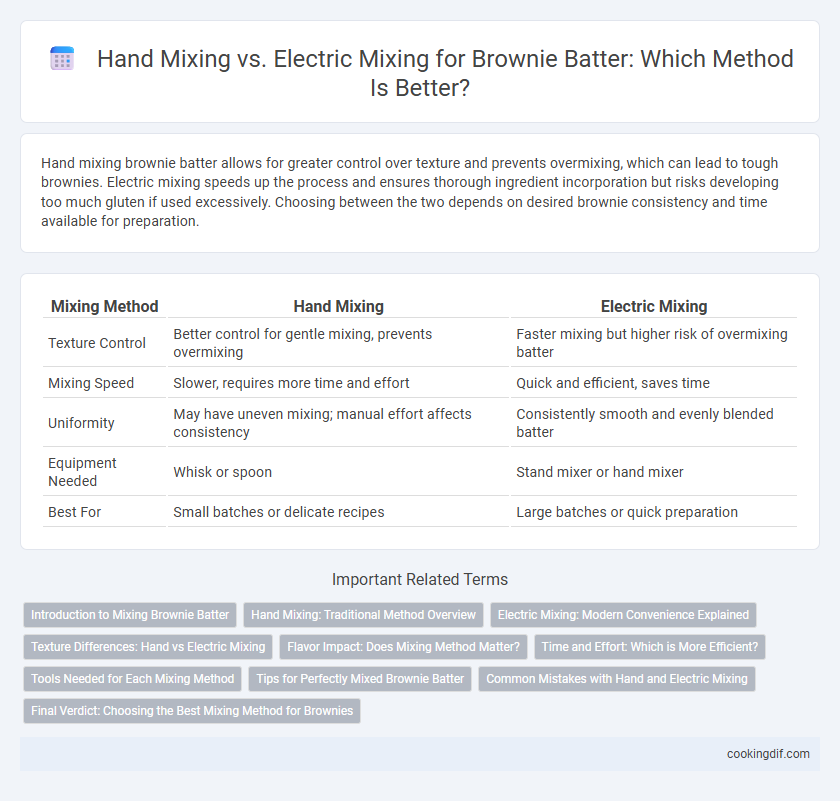Hand mixing brownie batter allows for greater control over texture and prevents overmixing, which can lead to tough brownies. Electric mixing speeds up the process and ensures thorough ingredient incorporation but risks developing too much gluten if used excessively. Choosing between the two depends on desired brownie consistency and time available for preparation.
Table of Comparison
| Mixing Method | Hand Mixing | Electric Mixing |
|---|---|---|
| Texture Control | Better control for gentle mixing, prevents overmixing | Faster mixing but higher risk of overmixing batter |
| Mixing Speed | Slower, requires more time and effort | Quick and efficient, saves time |
| Uniformity | May have uneven mixing; manual effort affects consistency | Consistently smooth and evenly blended batter |
| Equipment Needed | Whisk or spoon | Stand mixer or hand mixer |
| Best For | Small batches or delicate recipes | Large batches or quick preparation |
Introduction to Mixing Brownie Batter
Hand mixing brownie batter allows better control over the texture, helping to prevent overmixing that can result in dense, tough brownies. Electric mixers, while faster and efficient, can easily incorporate too much air, leading to a lighter, cakier consistency not typical of traditional fudgy brownies. Understanding the impact of each mixing method is essential to achieving the desired brownie texture with optimal crumb and moisture.
Hand Mixing: Traditional Method Overview
Hand mixing brownie batter preserves the ideal texture by gently combining ingredients without overdeveloping gluten, resulting in a tender, fudgy crumb. This traditional method allows for greater control over consistency and prevents the incorporation of excessive air, which can alter the final density. Home bakers favor hand mixing for its ability to maintain the classic, rich texture characteristic of authentic brownies.
Electric Mixing: Modern Convenience Explained
Electric mixing offers consistent speed and thorough blending, ensuring even distribution of ingredients for a smoother brownie batter texture. It reduces mixing time significantly compared to hand mixing, optimizing preparation efficiency in busy kitchens. Modern electric mixers feature adjustable settings to prevent overmixing, preserving the ideal fudgy and tender brownie crumb.
Texture Differences: Hand vs Electric Mixing
Hand mixing brownie batter typically produces a denser, fudgier texture by gently combining ingredients without over-aeration. Electric mixing introduces more air into the batter, resulting in a lighter, cakier crumb with increased volume. The choice between hand and electric mixing directly influences the final brownie texture, affecting moisture retention and crumb structure.
Flavor Impact: Does Mixing Method Matter?
Hand mixing brownie batter preserves air bubbles more gently, resulting in a denser, fudgier texture that enhances rich chocolate flavors. Electric mixing incorporates more air, producing a lighter crumb but potentially diluting the intense cocoa taste. Choosing hand mixing optimizes flavor depth by maintaining batter integrity and minimizing over-aeration.
Time and Effort: Which is More Efficient?
Hand mixing brownie batter requires significantly more time and physical effort compared to electric mixing, which can blend ingredients uniformly within minutes. Electric mixers offer consistent speed and power, reducing fatigue and enabling faster preparation without compromising texture. For efficient baking, electric mixing is the preferred method to save time and minimize manual labor while achieving smooth, well-incorporated brownie batter.
Tools Needed for Each Mixing Method
Hand mixing brownies requires only a sturdy mixing bowl and a wooden spoon or a whisk, providing a simple and low-tech toolset ideal for small batches. Electric mixing demands a handheld or stand mixer equipped with beaters, which speeds up the process and ensures a smoother batter consistency. Choosing tools depends on texture preference and convenience, with electric mixers offering precise control while hand mixing preserves traditional methods.
Tips for Perfectly Mixed Brownie Batter
Hand mixing brownie batter offers better control over the texture, preventing overmixing that can toughen the brownies. Using a sturdy wooden spoon or silicone spatula, gently fold ingredients until just combined to maintain a tender crumb. Electric mixers can incorporate too much air, leading to cakier brownies rather than the desired fudgy consistency.
Common Mistakes with Hand and Electric Mixing
Hand mixing brownies can lead to common mistakes such as uneven batter consistency and incomplete incorporation of ingredients, resulting in dense or unevenly baked brownies. Electric mixers are prone to overmixing, which introduces excess air and toughens the brownie texture, causing a cakey rather than fudgy finish. Achieving the ideal brownie texture requires careful control over mixing speed and duration to balance ingredient integration without overworking the batter.
Final Verdict: Choosing the Best Mixing Method for Brownies
Hand mixing preserves the dense, fudgy texture essential for the perfect brownie while preventing overmixing that can lead to toughness. Electric mixing introduces more air, resulting in a lighter, cakey crumb which may not align with traditional brownie expectations. Choosing hand mixing ensures control over batter consistency, producing rich, moist brownies favored by purists.
hand mixing vs electric mixing for batter Infographic

 cookingdif.com
cookingdif.com